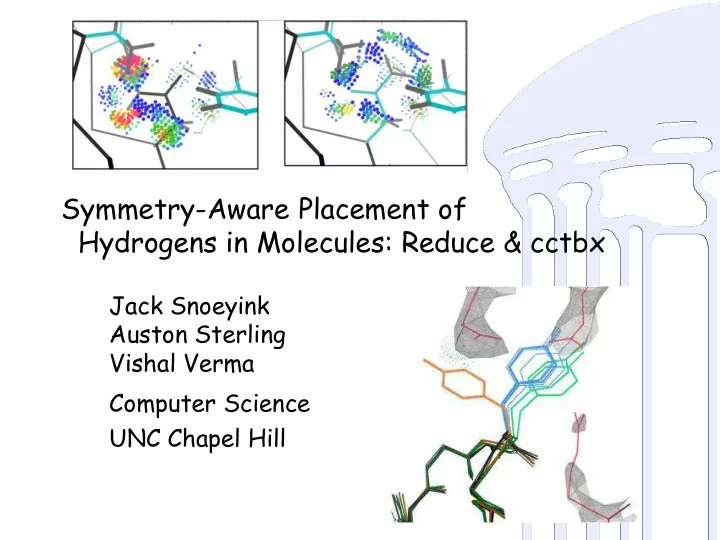

Symmetry-Aware Placement of Hydrogens in Molecules: Reduce & cctbx Jack Snoeyink Auston Sterling Vishal Verma Computer Science UNC Chapel Hill
Outline Determining Molecular Structure • Why: “central dogma” • How: X-ray crystallography – Role of symmetry Structure Validation • All Atom Contact Analysis: Molprobity • Hydrogen placement: Reduce Symmetry-aware Reduce: • SMP: simple matter of programming
Central Dogma of Biochemistry Sequence Structure Function
X-ray crystallography to find structure Sequence Structure Fu Make X-ray Electron Backbone Rotamer Structure crystal diffraction density threading placement Validation
Role of symmetry Sequence Structure Fu Make X-ray Electron Backbone Rotamer Structure crystal diffraction density threading placement Validation Of the 230 crystallographic space groups, 91 appear in the Protein Data Bank. 99% coverage by 53 groups 90% coverage by 21 groups
Vocabulary for symmetry (RCSB) Symmetry group action on Asymmetric unit gives Unit cell. Note: Asymmetric unit has a model; Model need not lie inside it, or inside the unit cell.
Asymmetric unit vs. Biological assembly Asymmetric unit with portion Asymmetric unit with Asymmetric unit multiple of a biological assembly one biological assembly biological assemblies Entry 1hho contains half a Entry 2hhb contains one Entry 1hv4 contains two hemoglobin molecule ( 2 chains ) hemoglobin molecule hemoglobin molecules in the asymmetric unit. A ( 4 chains ) in the ( 8 chains ) in the crystallographic two-fold axis asymmetric unit. asymmetric unit. generates the other 2 chains.
X-ray crystallography to find structure Sequence Structure Fu Make X-ray Electron Backbone Rotamer Structure crystal diffraction density threading placement Validation
Role of symmetry in threading Coot tutorial: • Density without structure may be symmetric copy • Check: turn on model symmetry Key point for me: • for consistency use their library: Comp. Cryst. Toolbox (cctbx)
All atom contact analysis: Molprobity demo
Reduce: Hydrogen placement by dynamic programming on graphs of small treewidth • Reduce considers flips & rotations, which may interact. • Interaction graphs’ small treewidth allows fast dynamic programming.
Single model analysis misses “crystal contacts” • Validation (Reduce) • Crystallography (PHENIX/Coot) • Protein folding (Rosetta) eg. analysis of Rosetta decoys: • native • decoys • symmetric natives
SymReduce: find neighbors Q: How should Reduce find its neighbors using the crystallographic symmetries? A : Bucketing…Reduce folds lattice into unit cell; cctbx library folds into asymmetric unit
SymReduce: find neighbors Copy atoms from the asymmetric unit that lie within an interaction distance limit of the asym. unit. Bucketing must be done in the Euclidean space.
SMP: “simple” matter of programming • To accommodate candidate H atom positions, we had to add query (x, y, z) functionality to cctbx; otherwise we’d need to add/delete -last. Remaining to do: • Testing in PHENIX • Naming convention for output of symmetric copies of atoms. Possible extensions • Speed up, e.g., queries by batching nearby dots. • Detect if the “right” symmetry has been specified.
Thanks • Richardson lab (Molprobity) • Ralf Grosse-Kunstleve (cctbx) • PHENIX • Rosetta Commons • NIH, NSF
Recommend
More recommend